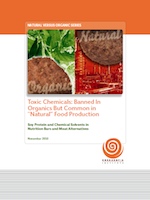 The difference between “organic” and “natural” just took on a much more critical meaning!
The difference between “organic” and “natural” just took on a much more critical meaning!
The term “natural” when used on food products is regulated only for meat and poultry. The USDA defines “natural” as:
A product containing no artificial ingredient or added color and is only minimally processed (a process which does not fundamentally alter the raw product) may be labeled natural. The label must explain the use of the term natural (such as – no added colorings or artificial ingredients; minimally processed.)
As consumers, we often assume “natural” on processed and packaged foods to mean pretty much the same. Nothing could be further from the truth.
The use of the term “natural” on food packages is mostly unregulated. Companies freely use the “natural” label without any government oversight or verified commitment to ecological and safe production practices, such as organic certification. In most cases, the company and its marketing department determine their own definition and meaning of the term “natural.”
The Cornucopia Institute, in its latest report in its Natural vs Organic series, has highlighted the use of hexane in soybean processing. Hexane is a byproduct of gasoline refining and is used by soybean processors as a solvent to extract the oil from soybeans.
So what’s the problem with hexane? According to the Centers for Disease Control (CDC) it is a neurotoxin and the Environmental Protection Agency (EPA) call sit a “hazardous air pollutant.”
Before you eat your next soy-based veggie burger or energy bar, read “Toxic Chemicals: Banned in Organics but Common In ‘Natural’ Food Production.”
